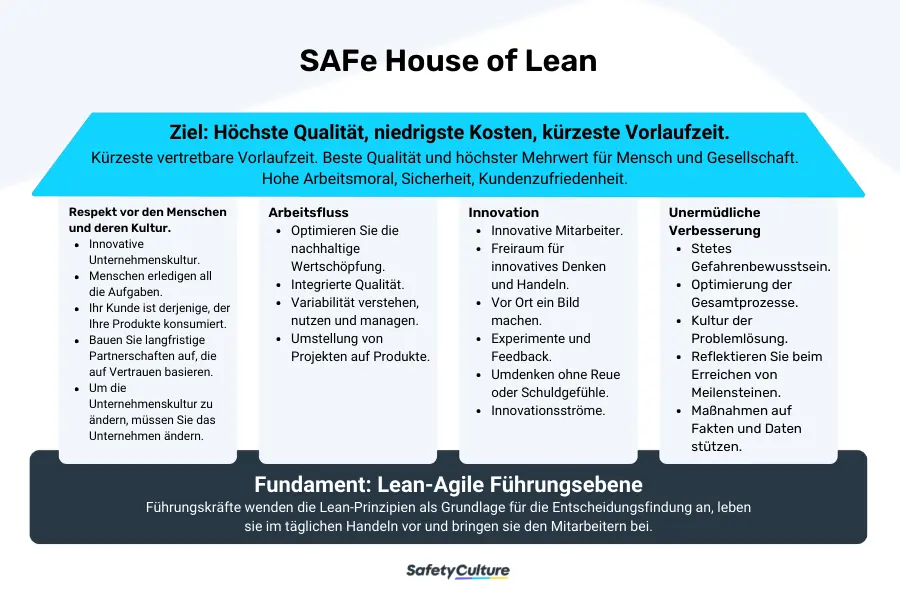What is the House of Lean?
The House of Lean visualizes the structure of Lean when implemented in organizations. It shows the Lean method as a house whose components work together to achieve the desired goals. Just as its name suggests, House of Lean anchors itself on the concepts, strategies, and principles of Lean manufacturing.
This visual representation guides organizations in optimizing their manufacturing and operations using the Lean method. It focuses on solving problems and continuously evolving through innovative principles and practices. Find out more about this methodology in the succeeding sections.
What is the Goal of the House of Lean?
The House of Lean illustrates a clear flow of processes in realizing the Lean method. It shapes the principles and practices that organizations need in carrying out the Lean vision. It can also be used with other frameworks such as SWOT.
As mentioned earlier, it likens the Lean process to a house. Each part plays an essential role in holding the Lean house together. For example, the roof (goals) needs the support of sturdy pillars (principles and practices) and a solid foundation (leadership).
In other words, the synergy of these elements helps organizations reach their targets. Ultimately, the goal is to provide value to customers using less waste and fewer resources.
Toyota House of Lean
After the Second World War, Toyota pioneered a production system that would radically change the game in the following years.
The Toyota Production System (TPS) became the answer to the inefficiencies of the traditional production model. It focused on optimizing production by eliminating waste in the system. This way, companies could deliver products and services of the highest quality at the lowest cost and in the shortest lead time.
The Toyota House of Lean, as shown in the diagram below, illustrates the TPS to help organizations better understand how it works. This visualization consists of the roof, the pillars, and the foundations. The following sections will explore these components one by one.

Two-Pillar Toyota House of Lean
Roof
Developing a product, service, or idea begins with the customer in mind. After all, they are the primary consumers of the product, service, or capability.
With this in mind, it follows to put them at the top of the House of Lean. The roof represents the organization’s goal: to create the highest quality products at the lowest possible cost and in the shortest lead time. By prioritizing and attaining customer satisfaction, companies gain an advantage over their competitors.
So how can companies deliver what their customers want? They need to satisfy these four elements:
- Quality
- Variety
- Reasonable price
- Product performance
Pillars
The Toyota House of Lean rests on two (2) pillars: Jidoka and Just-in-Time (JIT). Later, Toyota would add another pillar, People and Teamwork, to strengthen the house. These pillars support the roof and drive organizations to achieve their goals.
Jidoka
This pillar comes from the Japanese term meaning “autonomation.” In other words, Jidoka is all about automation with a human touch.
Jidoka puts machines to a safe stop whenever problems arise. It captures these faults at the onset before they affect the rest of the production line.
This way, companies can prevent injuries, minimize damage, and promote long-term solutions. Moreover, it encourages them to build and improve systems until they are safe and sturdy.
Just-in-Time (JIT)
Just-in-Time (JIT) follows the principle of making the right products at the right time and in the right quantity. By delivering customer demand without excess, it removes the seven wastes (Muda): overproduction, inventory, motion, defects, overprocessing, waiting, and transport. To achieve this, the just-in-time model provides the following tools:
- Continuous flow: keeping the workstream flowing smoothly without interruptions;
- Takt time: optimizing production time to meet customer needs; and
- Pull system: starting new processes only if there’s consumer demand.
People and Teamwork
This pillar adds another dimension to improve the two-pillar system. Just as the name suggests, it revolves around the people and how they work with each other.
To create an environment suitable for Lean construction and manufacturing, companies need to pay attention to:
- Selecting the right people
- Achieving common goals
- Building consensus within the team
- Cross-training individuals
Moreover, this pillar also emphasizes teamwork in resolving problems. It provides the following tools to enable this process:
- Genchi Genbutsu (Go See): laying down the facts about what happened in the production area to solve problems accurately
- 5 Whys: analyzing problems to get to their root cause by asking “Why?” 5 times. This template can help you get started on the process
- Hansei (Reflection): digging deeper into past mistakes to uncover long-term solutions
With the addition of this pillar, the Toyota House of Lean will look like the diagram below.

Three-Pillar Toyota House of Lean
Foundations
It is a common saying that a house with good foundations lasts longer. This statement rings true with the Toyota House of Lean. These components—heijunka, standardized work, and kaizen—provide a stable foundation to help sustain the Lean process.
Heijunka
The term heijunka in Japanese means “leveling.” True to its name, it levels the type and quantity of production based on what the customer needs. Using this method, companies can save costs and avoid overproduction while meeting customer demands.
Standardized Work
Another component in the Toyota House of Lean foundations is standardized work. It optimizes the production process by having the most effective and efficient people, materials, assets, and equipment at present to do the job. In doing so, companies can maintain the same high quality for all their products.
The word “standardized” may sound like something static or unchanging to some, but that isn’t the case. Instead, standardized work is all about the best means possible at the moment. It encourages companies to improve their standard operations continuously.
Kaizen
As mentioned earlier, practices and methods in a Toyota House of Lean are rarely static. Instead, they move dynamically as they consistently find ways to improve.
Kaizen embodies this foundation. It aims to improve value streams and individual processes to enhance the quality of products with less waste. It does so on two levels:
- System/flow kaizen: improving management systems to promote overall value stream
- Process kaizen: developing efficient individual processes with teams and leaders
SAFe House of Lean
In the previous section, the Toyota House of Lean provides a comprehensive view of how organizations can optimize their production systems without wasting time and resources.
The Scaled Agile Framework (SAFe) House of Lean takes this endeavor one step further. It aims to transform practices and processes at the organizational level with the help of the Agile Manifesto. Together, they form what is known as the SAFe Lean-Agile Mindset.
This section will look closely into each component of this house, as shown in the diagram below.

SAFe House of Lean
Foundation
In the SAFe House of Lean, great teams often begin with their leaders. This component enables teams to succeed in their desired goals.
Thus, to successfully implement the SAFe House of Lean, companies need to start with the leadership team. Managers and supervisors must embrace Lean-Agile values to achieve business agility. They can do so by following these three dimensions:
- Leading by example: practicing desired behaviors for others to follow;
- Mindset and principles: using the Lean-Agile approach in actions, responses, decisions; and
- Leading change: shaping the work environment, providing resources, and training people in the Lean-Agile way.
Pillars
The SAFe House of Lean consists of four pillars reinforcing the Lean methodology. It optimizes standard processes using Lean strategies and tools specific to the production area.
In implementing these pillars, leaders can use the 5s Lean principles, Kanban, Jidoka, JIT production, 5 Whys, and other Lean tools.
Pillar 1: Respect for People and Culture
The first pillar, respect for people and culture, is a must for any organization. Treating employees with respect empowers them to contribute and improve practices. When employees are valued and listened to, they also do their part in finding better ways of operating.
In other words, this pillar drives people to foster a safe, positive, and performance-led environment. Thus, change must come from within—from company practices to the leaders’ approach.
Pillar 2: Flow
The second pillar pushes for a seamless flow of value delivery in organizations. It involves constantly receiving feedback (from customers, managers, and other teammates) and adjusting components. In doing so, companies can deliver value at an agile pace.
This continuous flow follows these principles:
- Understanding how value development streams work
- Anticipating and limiting Work In Progress (WIP) lines
- Lessening batch sizes in production
- Handling queue lengths
Keeping this flow requires continuously seeking ingenious ways to remove wasteful practices. From a management perspective, it starts by changing its approach from short-term projects to long-term products.
Pillar 3: Innovation
To maintain a smooth flow of operations, companies need to find new ways to enhance their value delivery. Otherwise, their products would remain stagnant.
Innovation, the third pillar, furthers this cause. Part of the Lean process involves continuous improvement. One of the best ways to do that is through constant innovation.
What Best Supports Innovation in the SAFe House of Lean?
Nurture innovative ideas in the workplace by:
- Providing coaching and mentorship opportunities
- Allowing enough room for employees to explore ideas
- Fostering a safe and open environment that enables workers to innovate with purpose
- Validating their ideas with customers and adjusting plans as needed
- Harmonizing the efforts of teams and upper management in developing new products and services
Pillar 4: Relentless Improvement
The final pillar, relentless improvement, requires shifting from a fixed mindset to a growth one. It encourages learning and development among the ranks in the company.
Having a growth mindset involves reflecting on previous works and enhancing current processes. To cultivate this pillar, companies must:
- Optimize the entire organization and its development processes
- Inculcate a problem-solving mindset to improve daily operations
- Identify and address weaknesses through systematic reflection
- Use Lean tools to find the root causes of inefficient practices and respond accordingly
Roof
All efforts in optimizing processes can only become fruitful if the resulting product or service satisfies customers. Thus, the roof symbolizes customer focus at the top of the SAFe House of Lean.
This means that companies must consider customer needs and wants when employing Lean strategies. After all, the goal is to bring customers the best value for their money in the shortest sustainable lead-time while eliminating waste.
Advantages of Using this Framework
The SAFe House of Lean offers companies many strategic advantages to propel their business to new heights. It enables organizations to:
- Produce great leaders that inspire people in the company
- Develop the skill sets of employees to design, build, test, and deliver value
- Promote creativity and innovation in an open, safe environment
- Forge trust amongst team members and clients alike
- Improve organizational systems and protocols, including safety measures
- Deliver products and services while conserving time and resources
Promote Quality Management Using SafetyCulture (formerly iAuditor)
The House of Lean helps in improving your organization’s quality management systems and practices. It guides you in delivering high-quality products and services without wasting precious resources. But with a multitude of tools at your disposal, it’s easy to get lost in the Lean process.
Luckily, digital platforms such as SafetyCulture can help you. It streamlines your efforts in integrating the Lean principles using the following functions:
- Customize and share pre-made checklists to ensure processes are followed.
- Establish workflows with scheduled inspections, reports, and more.
- Proactively resolve problems at their onset with Actions.
- Disseminate information across teams quickly using Heads Up.
- Formulate evidence-based strategies and solutions using data and analytics.
- Train employees to follow and uphold Lean principles in carrying out safe and quality work.




